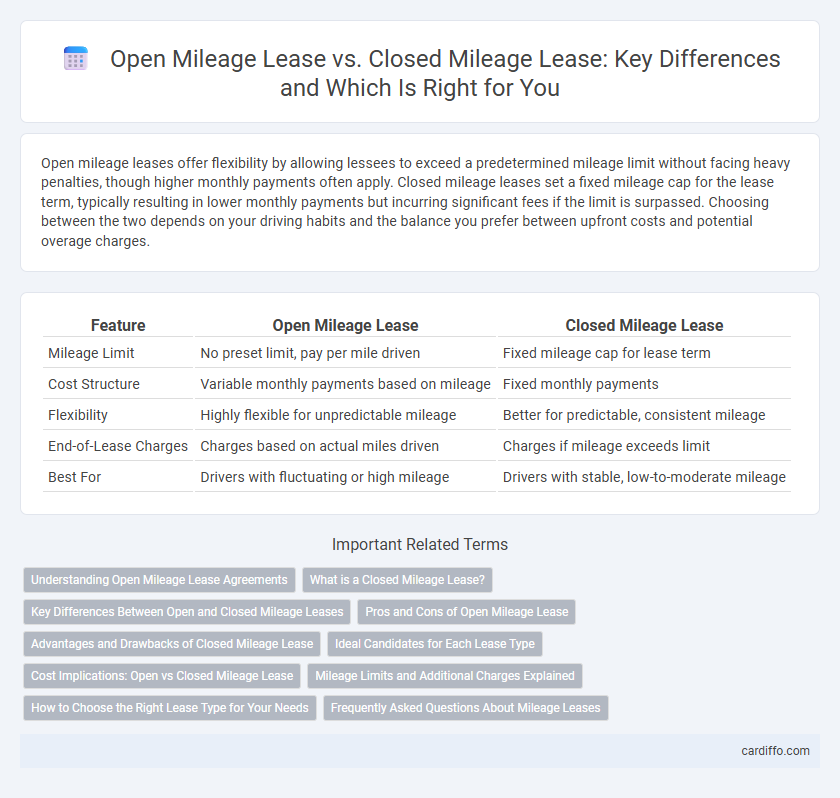Open mileage leases offer flexibility by allowing lessees to exceed a predetermined mileage limit without facing heavy penalties, though higher monthly payments often apply. Closed mileage leases set a fixed mileage cap for the lease term, typically resulting in lower monthly payments but incurring significant fees if the limit is surpassed. Choosing between the two depends on your driving habits and the balance you prefer between upfront costs and potential overage charges.
Table of Comparison
| Feature | Open Mileage Lease | Closed Mileage Lease |
|---|---|---|
| Mileage Limit | No preset limit, pay per mile driven | Fixed mileage cap for lease term |
| Cost Structure | Variable monthly payments based on mileage | Fixed monthly payments |
| Flexibility | Highly flexible for unpredictable mileage | Better for predictable, consistent mileage |
| End-of-Lease Charges | Charges based on actual miles driven | Charges if mileage exceeds limit |
| Best For | Drivers with fluctuating or high mileage | Drivers with stable, low-to-moderate mileage |
Understanding Open Mileage Lease Agreements
Open mileage lease agreements offer flexibility by allowing lessees to exceed the predetermined mileage limits without incurring penalties, though they often come with higher monthly payments compared to closed mileage leases. These leases are ideal for drivers with unpredictable or above-average mileage needs, as they provide the benefit of unrestricted driving distance while maintaining the advantage of lower upfront costs. Understanding the terms of open mileage leases is crucial, including how excess mileage fees are structured and the impact on overall lease expenses.
What is a Closed Mileage Lease?
A Closed Mileage Lease specifies a fixed number of miles that can be driven during the lease term, with penalties applied for exceeding the agreed mileage limit. This type of lease typically offers lower monthly payments compared to open mileage leases due to the reduced risk for the leasing company. Closed mileage leases are ideal for drivers with predictable, limited mileage needs who want to avoid excess mileage fees.
Key Differences Between Open and Closed Mileage Leases
Open mileage leases allow drivers unlimited miles or have flexible mileage limits, reducing penalties for exceeding mileage but often result in higher monthly payments. Closed mileage leases specify a fixed mileage limit for the lease term, with additional charges applied for any miles driven beyond the limit, making them more cost-effective for predictable driving patterns. Selecting between open and closed mileage leases depends on anticipated annual mileage and budget preferences to optimize lease costs and avoid unexpected fees.
Pros and Cons of Open Mileage Lease
Open Mileage Lease offers flexibility by allowing lessees to drive unlimited miles without penalties, ideal for high-mileage drivers or those with unpredictable travel needs. This type of lease often carries higher monthly payments compared to Closed Mileage Lease, reflecting the increased risk for lessors. The primary downside includes potentially higher costs and difficulty predicting total expenses, despite the advantage of avoiding over-mileage fees.
Advantages and Drawbacks of Closed Mileage Lease
Closed Mileage Lease offers predictable monthly payments due to a fixed mileage allowance, reducing the risk of unexpected charges at lease end. The main advantage is cost control, as lessees avoid excess mileage fees by staying within the agreed limit. However, the drawback lies in its inflexibility, potentially incurring significant penalties if actual mileage exceeds the contract, making it less ideal for high-mileage drivers.
Ideal Candidates for Each Lease Type
Open mileage leases suit drivers with unpredictable or high annual mileage needs, such as salespeople or those frequently traveling for work, minimizing penalties for exceeding mileage limits. Closed mileage leases fit drivers with stable, low to moderate mileage patterns, like commuters or city drivers, offering lower monthly payments with a fixed mileage cap. Selecting the right lease type depends on accurately forecasting annual mileage to avoid costly excess mileage charges or unnecessary upfront costs.
Cost Implications: Open vs Closed Mileage Lease
Open mileage leases typically result in higher monthly payments because they offer flexibility without mileage limits, leading to increased depreciation risk for lessors. Closed mileage leases have predetermined mileage caps, often resulting in lower monthly payments but potential excess mileage charges if the limit is exceeded. Choosing between open and closed mileage leases involves balancing upfront lease costs against the risk of additional fees based on actual vehicle usage.
Mileage Limits and Additional Charges Explained
Open mileage leases offer flexible mileage limits without predefined caps, allowing lessees to drive unrestricted miles but usually entail higher monthly payments. Closed mileage leases set a fixed, predetermined mileage limit, typically between 10,000 to 15,000 miles per year, with penalties applied for exceeding these limits. Additional charges in closed leases can include excess mileage fees calculated per mile, often ranging from $0.15 to $0.30, which significantly increase the overall lease cost if limits are surpassed.
How to Choose the Right Lease Type for Your Needs
Choosing the right lease type depends on your anticipated annual mileage and budget flexibility. Open mileage leases offer lower monthly payments with mileage charges for excess, ideal for drivers with uncertain or low mileage. Closed mileage leases include a fixed mileage limit, providing predictable costs suitable for drivers with consistent, predictable mileage patterns.
Frequently Asked Questions About Mileage Leases
Open mileage leases offer flexibility by allowing unrestricted mileage but often come with higher monthly payments due to mileage risk. Closed mileage leases set a fixed mileage limit, typically between 10,000 and 15,000 miles per year, with penalties for exceeding the cap, providing predictable costs for lessees. Choosing between open and closed mileage leases depends on driving habits, budget, and preference for payment stability versus mileage flexibility.
Open Mileage Lease vs Closed Mileage Lease Infographic

 cardiffo.com
cardiffo.com